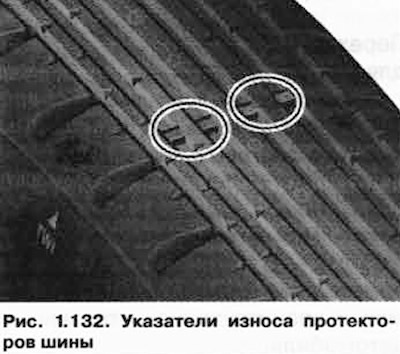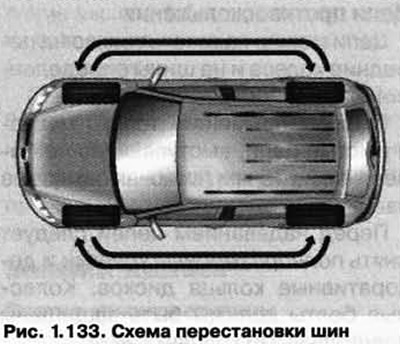Preventing wheel and tire damage
Drive over curbs and other similar obstacles slowly and as straight as possible.
Protect tires from oil, grease and fuel.
Check tires regularly for damage (punctures, cuts, cracks). Remove foreign objects from the tread.
Tire storage
Mark the removed tires in order to maintain the same direction of rotation of the tire when re-installing it on the car.
Store removed wheels and tires in a cool, dry and dark place.
Stand the tires upright if they are not mounted on a rim.
New tires
New tires should «roll up».
Depending on the design and profile of the tread, the tread depth of new tires may vary between tires of different designs and different manufacturers.
Hidden damage
Damage to tires and rims is often not visible. Unusual vibration or sideways driving may indicate a defective tire. In this case, you should definitely check the condition of the tires in a Volkswagen service company.
Tires with directional tread pattern
Tires with a directional tread pattern have arrows on the sidewall. The indicated direction must be ensured when mounting the wheels on the vehicle. At the same time, all the advantages of such tires in terms of grip, wear, noise and aquaplaning are realized.
Tire pressure check
NOTE: Tire pressure ratings are on a sticker on the end of the driver's door.
Check the information on the sticker, what should be the tire pressure.
Mount the pressure gauge directly on the dust cap without unscrewing it.
Always check pressure when tires are cold. Do not bleed air at high pressure in hot tires.
Adjust the tire pressure to the vehicle load.
Tire pressure
The presence of nominal pressure in tires is especially important at high-speed movement. Tire pressure should be checked at least once a month and before every long trip.
Tire mileage
NOTE: Tire mileage depends on tire pressure, driving style, and rim mounting quality.
Tire wear indicators
The tread pattern has 1.6 mm high tire wear indicators located across the tread (pic. 1.132). Such indicators numbering from 6 to 8 are located at an equal distance from each other on the tread of the tire. Tire sidewall marking (for example, notation «TWI» or pictograms) indicate the location of the wear indicators. The remaining pattern height of 1.6 mm - measured in the profile groove near the wear indicator - is the minimum to allow the vehicle to be driven. Worn tires should be replaced.

Incorrect tire pressure leads to increased tire wear and can even cause a tire to burst. Therefore, you should check the tire pressure at least once a month.
High-speed cornering, hard acceleration and braking also increase tire wear.
Tire swap
With a clearly increased wear of the tires of the front wheels, it is recommended to swap the front wheels with the rear ones in accordance with the diagram in Figure 1.133. Thanks to this, all tires will have the same mileage.

Wheel balancing
The wheels of the new car are balanced. During operation, for various reasons, an imbalance of the wheels may occur, which manifests itself in a violation of the smoothness of the ride and a deterioration in the controllability of the car.
If the imbalance increases the wear of the steering, suspension and tires - the wheels must be re-balanced. In addition, wheel balancing is necessary when changing a tire.
Winter tires
In winter conditions, the behavior of the car is significantly improved when using winter tires. This also applies to all-wheel drive vehicles. Summer tires due to their design features (width, tread pattern, rubber compound) glide on snow and ice.
Use winter tires on all four wheels.
The permitted sizes of winter tires are specified in the vehicle documentation. Use only radial tires. All tire sizes listed in the documentation apply to winter tires.
Winter tires lose their performance to a large extent when the tread depth is reduced to 4mm.
For winter tires, depending on the speed index, the following speed limits apply:
- T - max. 190 km/h;
- I - max. 210 km/h
When using winter tires with a speed index V, the speed limit and tire pressure are determined by the engine power. Ask a Volkswagen dealer for the maximum speed limit and the required tire pressure.
Anti-skid chains
Chains can only be worn on the front wheels and tires of a certain size.
Only fine-mesh chains should be used, protruding no more than 15 mm (including lock links).
Before putting on the chains, remove the full-size hubcaps and decorative rings of the discs. Wheel bolts must be protected with special caps.

Visitor comments